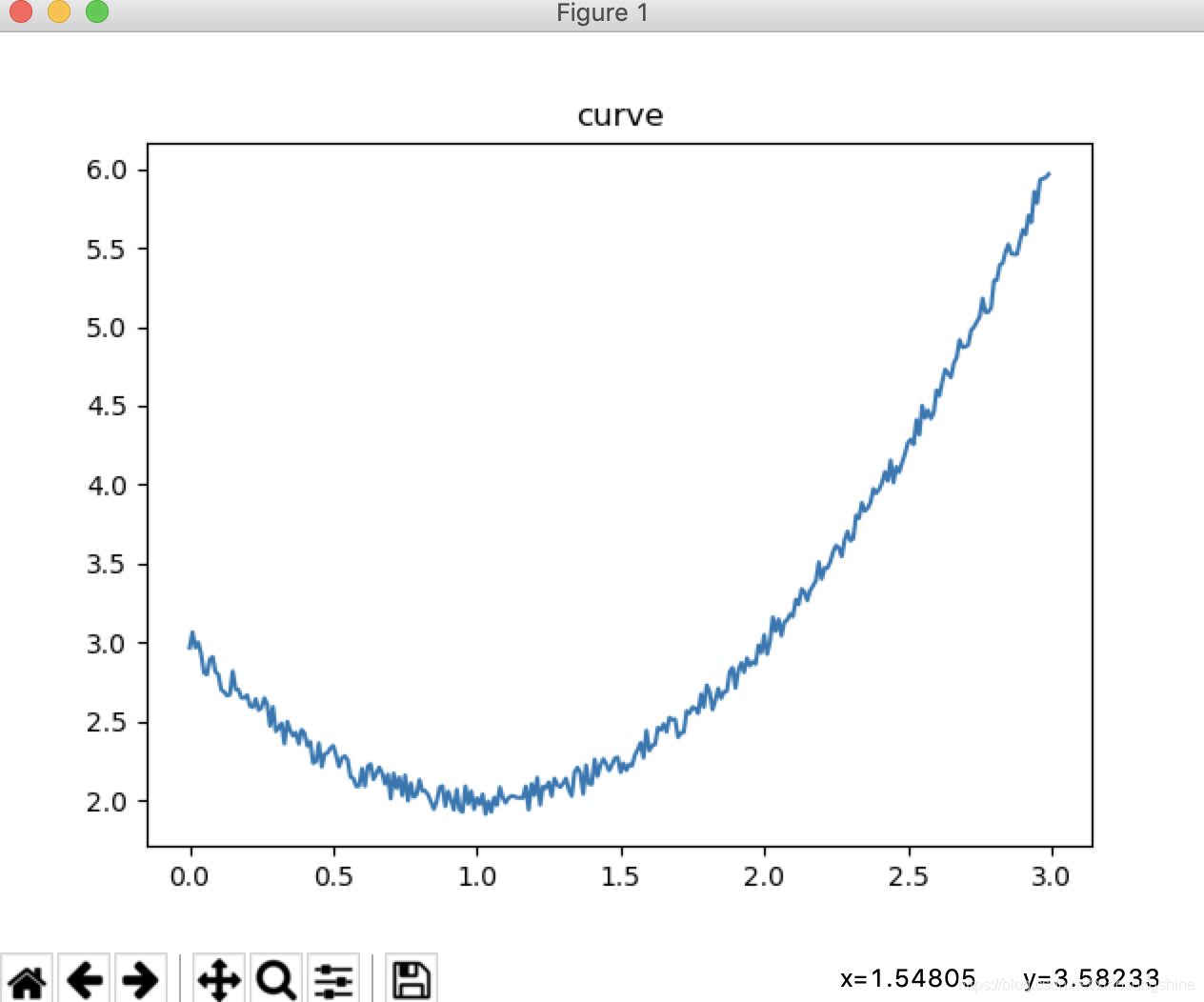[深度學習入門]實戰三·使用TensorFlow擬合曲線
阿新 • • 發佈:2018-12-01
[深度學習入門]實戰三·使用TensorFlow擬合曲線
-
問題描述
擬合y= x*x -2x +3 + 0.1(-1到1的隨機值) 曲線
給定x範圍(0,3) -
問題分析
在上篇部落格中,我們使用最簡單的y=wx+b的模型成功擬合了一條直線,現在我們在進一步進行曲線的擬合。簡單的y=wx+b模型已經無法滿足我們的需求,需要利用更多的神經元來解決問題了。 -
生成資料
import numpy as np
import matplotlib.pyplot as plt
import tensorflow as tf
def get_data(x, 生成的資料影象為:

- 搭建網路結構
x = tf.placeholder(tf.float32,[None,1])
y_ = tf.placeholder( - 定義學習函式
loss = tf.reduce_mean(tf.square(y-y_))
opt = tf.train.GradientDescentOptimizer(0.02).minimize(loss)
- 訓練網路引數
with tf.Session() as sess:
srun = sess.run
init = tf.global_variables_initializer()
srun(init)
for e in range(4001):
loss_val,_ = srun([loss,opt],{x:xs,y_:ys})
if(e%200 ==0):
print("%d steps loss is %f"%(e,loss_val))
ys_pre = srun(y,{x:xs})
- 顯示預測結果
plt.title("curve")
plt.plot(xs,ys)
plt.plot(xs,ys_pre)
plt.legend("ys","ys_pre")
plt.show()
- 執行結果
log:
0 steps loss is 49.556065
200 steps loss is 0.352589
400 steps loss is 0.108551
600 steps loss is 0.042510
800 steps loss is 0.030316
1000 steps loss is 0.024551
1200 steps loss is 0.020459
1400 steps loss is 0.017488
1600 steps loss is 0.015306
1800 steps loss is 0.013710
2000 steps loss is 0.012510
2200 steps loss is 0.011569
2400 steps loss is 0.010802
2600 steps loss is 0.010148
2800 steps loss is 0.009566
3000 steps loss is 0.009039
3200 steps loss is 0.008552
3400 steps loss is 0.008097
3600 steps loss is 0.007674
3800 steps loss is 0.007285
4000 steps loss is 0.006934
執行結果圖

- 完整程式碼
import os
os.environ["KMP_DUPLICATE_LIB_OK"]="TRUE"
import numpy as np
import matplotlib.pyplot as plt
import tensorflow as tf
def get_data(x,w,b,d):
c,r = x.shape
y = (w * x * x + b*x + d)+ (0.1*(2*np.random.rand(c,r)-1))
return(y)
xs = np.arange(0,3,0.01).reshape(-1,1)
ys = get_data(xs,1,-2,3)
"""plt.title("curve")
plt.plot(xs,ys)
plt.show()"""
x = tf.placeholder(tf.float32,[None,1])
y_ = tf.placeholder(tf.float32,[None,1])
w1 = tf.get_variable("w1",initializer=tf.random_normal([1,16]))
w2 = tf.get_variable("w2",initializer=tf.random_normal([16,1]))
b1 = tf.get_variable("b1",initializer=tf.zeros([1,16]))
b2 = tf.get_variable("b2",initializer=tf.zeros([1,1]))
l1 = tf.matmul(x,w1)+b1
l1 = tf.nn.elu(l1)
y = tf.matmul(l1,w2)+b2
loss = tf.reduce_mean(tf.square(y-y_))
opt = tf.train.GradientDescentOptimizer(0.02).minimize(loss)
with tf.Session() as sess:
srun = sess.run
init = tf.global_variables_initializer()
srun(init)
for e in range(4001):
loss_val,_ = srun([loss,opt],{x:xs,y_:ys})
if(e%200 ==0):
print("%d steps loss is %f"%(e,loss_val))
ys_pre = srun(y,{x:xs})
plt.title("curve")
plt.plot(xs,ys)
plt.plot(xs,ys_pre)
plt.legend("ys","ys_pre")
plt.show()
